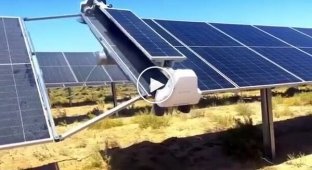How the Internet works around the world (9 photos)
Very interesting information about how the World Wide Web - the Internet - was created, how communication is carried out between different continents of our planet, how a fiber optic cable is laid along the bottom of the ocean and many more interesting facts. I recommend everyone to read it.

What you see above is a submarine communications cable.
It is 69 millimeters in diameter, and it is it that carries 99% of all international communication traffic (i.e. Internet, telephony and other data). It connects all the continents of our planet, with the exception of Antarctica. These amazing fiber optic cables cross all the oceans, and they are hundreds of thousands, and what can I say, millions of kilometers long.
Submarine Cable Network World Map



This is the "CS Cable Innovator", it is specially designed for laying fiber optic cable and is the largest ship of its kind in the world. It was built in 1995 in Finland, it is 145 meters long and 24 meters wide. It is capable of transporting up to 8,500 tons of fiber optic cable. The ship has 80 cabins, of which 42 are officer cabins, 36 are crew cabins and two luxury cabins.
Without maintenance and refueling, it can operate for 42 days, and if it is accompanied by a support ship, then all 60.

Originally, submarine cables were simple point-to-point connections. Nowadays, underwater cables have become more complex and they can split and branch right on the ocean floor.

Since 2012, the provider has successfully demonstrated an underwater data transmission channel with a throughput of 100 Gbit/s. It stretches across the entire Atlantic Ocean and its length is 6000 kilometers. Imagine that three years ago the capacity of the Atlantic communication channel was 2.5 times less and was equal to 40 Gbit/s. Now ships like the CS Cable Innovator are constantly working to provide us with fast intercontinental Internet.
Submarine communication cable cross-section

1. Polyethylene
2. Mylar coating
3. Stranded steel wires
4. Aluminum water protection
5. Polycarbonate
6. Copper or aluminum tube
7. Vaseline
8. Optical fibers

This is what it looks like at the bottom. What are the environmental consequences of laying telecommunications cables on the seabed? How does this affect the ocean floor and the animals that live there? Although literally millions of kilometers of communication cables have been placed on the seabed over the past century, this has not had any impact on the lives of underwater inhabitants. According to a recent study, the cable has only minor impacts on animals living and located within the seabed. In the photo above we see a variety of marine life near the undersea cable that crosses the continental shelf of Half Moon Bay.
Here the cable is only 3.2 cm thick.

Many feared that cable TV would overload channels, but in fact it only increased the load by 1 percent. Moreover, cable television, which can travel through underwater fibers, already has a throughput of 1 Terabit, while satellites provide 100 times less. And if you want to buy yourself such an inter-Atlantic cable, it will cost you 200-500 million dollars.





















